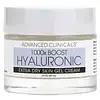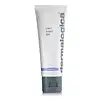What's inside
What's inside
 Key Ingredients
Key Ingredients

 Benefits
Benefits

 Concerns
Concerns

 Ingredients Side-by-side
Ingredients Side-by-side

Water
Skin ConditioningPropanediol
SolventDimethicone
EmollientGlycerin
HumectantPyrus Malus Fruit Extract
Skin ConditioningAmmonium Acryloyldimethyltaurate/Vp Copolymer
Sodium Hyaluronate
HumectantAloe Barbadensis Leaf Juice
Skin ConditioningDipotassium Glycyrrhizate
HumectantButylene Glycol
HumectantCaulerpa Lentillifera Extract
Oryza Sativa Bran Extract
Skin ConditioningRosmarinus Officinalis Leaf Extract
AntimicrobialHelianthus Annuus Extract
EmollientCymbopogon Martini Oil
MaskingCyanocobalamin
Skin ConditioningHydroxyethylcellulose
Emulsion StabilisingSea Salt
AbrasiveCarrageenan
Vaccinium Angustifolium Fruit Extract
Skin ProtectingAscorbic Acid
AntioxidantPolysorbate 20
EmulsifyingRosa Centifolia Flower Extract
AstringentPhenoxyethanol
PreservativeTocopherol
AntioxidantMaltodextrin
AbsorbentTetrasodium Glutamate Diacetate
Caprylyl Glycol
EmollientEthylhexylglycerin
Skin ConditioningSodium Hydroxide
BufferingHexylene Glycol
EmulsifyingCitric Acid
BufferingWater, Propanediol, Dimethicone, Glycerin, Pyrus Malus Fruit Extract, Ammonium Acryloyldimethyltaurate/Vp Copolymer, Sodium Hyaluronate, Aloe Barbadensis Leaf Juice, Dipotassium Glycyrrhizate, Butylene Glycol, Caulerpa Lentillifera Extract, Oryza Sativa Bran Extract, Rosmarinus Officinalis Leaf Extract, Helianthus Annuus Extract, Cymbopogon Martini Oil, Cyanocobalamin, Hydroxyethylcellulose, Sea Salt, Carrageenan, Vaccinium Angustifolium Fruit Extract, Ascorbic Acid, Polysorbate 20, Rosa Centifolia Flower Extract, Phenoxyethanol, Tocopherol, Maltodextrin, Tetrasodium Glutamate Diacetate, Caprylyl Glycol, Ethylhexylglycerin, Sodium Hydroxide, Hexylene Glycol, Citric Acid
Water
Skin ConditioningGlycerin
HumectantAloe Barbadensis Leaf Juice
Skin ConditioningDimethicone
EmollientButylene Glycol
HumectantPyrus Malus Fruit Extract
Skin Conditioning1,2-Hexanediol
Skin ConditioningDiethylhexyl Carbonate
EmollientOpuntia Ficus-Indica Stem Extract
Skin ConditioningSodium Hyaluronate
HumectantDipotassium Glycyrrhizate
HumectantHydrolyzed Sodium Hyaluronate
Skin ConditioningLavandula Angustifolia Flower Extract
CleansingStearyl Heptanoate
EmollientCetyl PEG/PPG-10/1 Dimethicone
EmulsifyingHydroxyacetophenone
AntioxidantSea Salt
AbrasiveDimethicone Crosspolymer
Emulsion StabilisingStearyl Caprylate
EmollientLauryl PEG-9 Polydimethylsiloxyethyl Dimethicone
Skin ConditioningPotassium Sorbate
PreservativeCitric Acid
BufferingSodium Benzoate
MaskingDisodium Phosphate
BufferingLinalool
PerfumingLimonene
PerfumingWater, Glycerin, Aloe Barbadensis Leaf Juice, Dimethicone, Butylene Glycol, Pyrus Malus Fruit Extract, 1,2-Hexanediol, Diethylhexyl Carbonate, Opuntia Ficus-Indica Stem Extract, Sodium Hyaluronate, Dipotassium Glycyrrhizate, Hydrolyzed Sodium Hyaluronate, Lavandula Angustifolia Flower Extract, Stearyl Heptanoate, Cetyl PEG/PPG-10/1 Dimethicone, Hydroxyacetophenone, Sea Salt, Dimethicone Crosspolymer, Stearyl Caprylate, Lauryl PEG-9 Polydimethylsiloxyethyl Dimethicone, Potassium Sorbate, Citric Acid, Sodium Benzoate, Disodium Phosphate, Linalool, Limonene
 Reviews
Reviews

Ingredients Explained
These ingredients are found in both products.
Ingredients higher up in an ingredient list are typically present in a larger amount.
Aloe Barbadensis Leaf Juice comes from leaves of the aloe plant. Aloe Barbadensis Leaf Juice is best known for helping to soothe sunburns. It is also anti-inflammatory, moisturizing, antiseptic, and can help heal wounds.
Aloe is packed with good stuff including Vitamins A, C, and E. These vitamins are antioxidants, which help fight free-radicals and the damage they may cause. Free-radicals are molecules that may damage your skin cells, such as pollution.
Aloe Barbadensis Leaf Juice also contains sugars. These sugars come in the form of monosaccharides and polysaccharides, folic acid, and choline. These sugars are able to help bind moisture to skin.
It also contains minerals such as calcium, 12 anthraquinones, fatty acids, amino acids, and Vitamin B12.
Learn more about Aloe Barbadensis Leaf JuiceButylene Glycol (or BG) is used within cosmetic products for a few different reasons:
Overall, Butylene Glycol is a safe and well-rounded ingredient that works well with other ingredients.
Though this ingredient works well with most skin types, some people with sensitive skin may experience a reaction such as allergic rashes, closed comedones, or itchiness.
Learn more about Butylene GlycolCitric Acid is an alpha hydroxy acid (AHA) naturally found in citrus fruits like oranges, lemons, and limes.
Like other AHAs, citric acid can exfoliate skin by breaking down the bonds that hold dead skin cells together. This helps reveal smoother and brighter skin underneath.
However, this exfoliating effect only happens at high concentrations (20%) which can be hard to find in cosmetic products.
Due to this, citric acid is usually included in small amounts as a pH adjuster. This helps keep products slightly more acidic and compatible with skin's natural pH.
In skincare formulas, citric acid can:
While it can provide some skin benefits, research shows lactic acid and glycolic acid are generally more effective and less irritating exfoliants.
Most citric acid used in skincare today is made by fermenting sugars (usually from molasses). This synthetic version is identical to the natural citrus form but easier to stabilize and use in formulations.
Read more about some other popular AHA's here:
Learn more about Citric AcidDimethicone is a type of synthetic silicone created from natural materials such as quartz.
What it does:
Dimethicone comes in different viscosities:
Depending on the viscosity, dimethicone has different properties.
Ingredients lists don't always show which type is used, so we recommend reaching out to the brand if you have questions about the viscosity.
This ingredient is unlikely to cause irritation because it does not get absorbed into skin. However, people with silicone allergies should be careful about using this ingredient.
Note: Dimethicone may contribute to pilling. This is because it is not oil or water soluble, so pilling may occur when layered with products. When mixed with heavy oils in a formula, the outcome is also quite greasy.
Learn more about DimethiconeDipotassium Glycyrrhizate comes from licorice root.
Extracts of licorice have demonstrated to have antibacterial, anti‐inflammatory, antiviral, antioxidant properties.
One component, glabridin, has extra potent antioxidant and soothing properties. It has also been found to block pigmentation from UVB rays in guinea pigs.
Licorice Root also contains a flavonoid. Flavonoids are a natural substance from in plants. Flavonoids also have antioxidant properties.
Another component, glycyrrhizin, has been found to have anti-inflammatory and antimicrobial benefits. This may make licorice root extract effective at treating acne. However, more research is needed to support this.
Liquiritin is one of the flavone compounds found in licorice. It has been found to help lighten skin by preventing tyrosinase from reacting with tyrosine. When the two react, protein is converted to melanin. Melanin is the substance in your body that gives your features pigmentation.
Licorice root is native to Southern Europe and Asia. It has been used in traditional Chinese medicine to help with respiratory issues.
Learn more about Dipotassium GlycyrrhizateGlycerin is already naturally found in your skin. It helps moisturize and protect your skin.
A study from 2016 found glycerin to be more effective as a humectant than AHAs and hyaluronic acid.
As a humectant, it helps the skin stay hydrated by pulling moisture to your skin. The low molecular weight of glycerin allows it to pull moisture into the deeper layers of your skin.
Hydrated skin improves your skin barrier; Your skin barrier helps protect against irritants and bacteria.
Glycerin has also been found to have antimicrobial and antiviral properties. Due to these properties, glycerin is often used in wound and burn treatments.
In cosmetics, glycerin is usually derived from plants such as soybean or palm. However, it can also be sourced from animals, such as tallow or animal fat.
This ingredient is organic, colorless, odorless, and non-toxic.
Glycerin is the name for this ingredient in American English. British English uses Glycerol/Glycerine.
Learn more about GlycerinPyrus Malus Fruit Extract is extract from Apples. Apples are rich in Vitamin C, sugars, and antioxidants.
The sugar in Apples are humectants and help hydrate the skin. On top of that, apples also contain some acids, such as malic acid. These acids may have a mild exfoliating effect.
Last, the phytochemicals found in apples are strong antioxidants. These antioxidants help with anti-aging as they protect your skin cells against oxidative damage.
Learn more about Pyrus Malus Fruit ExtractSea salt has abrasive or exfoliation properties. It can sensitize and dry out the skin.
Sodium Hyaluronate is hyaluronic acid's salt form. It is commonly derived from the sodium salt of hyaluronic acid.
Like hyaluronic acid, it is great at holding water and acts as a humectant. This makes it a great skin hydrating ingredient.
Sodium Hyaluronate is naturally occurring in our bodies and is mostly found in eye fluid and joints.
These are some other common types of Hyaluronic Acid:
Learn more about Sodium HyaluronateWater. It's the most common cosmetic ingredient of all. You'll usually see it at the top of ingredient lists, meaning that it makes up the largest part of the product.
So why is it so popular? Water most often acts as a solvent - this means that it helps dissolve other ingredients into the formulation.
You'll also recognize water as that liquid we all need to stay alive. If you see this, drink a glass of water. Stay hydrated!
Learn more about Water